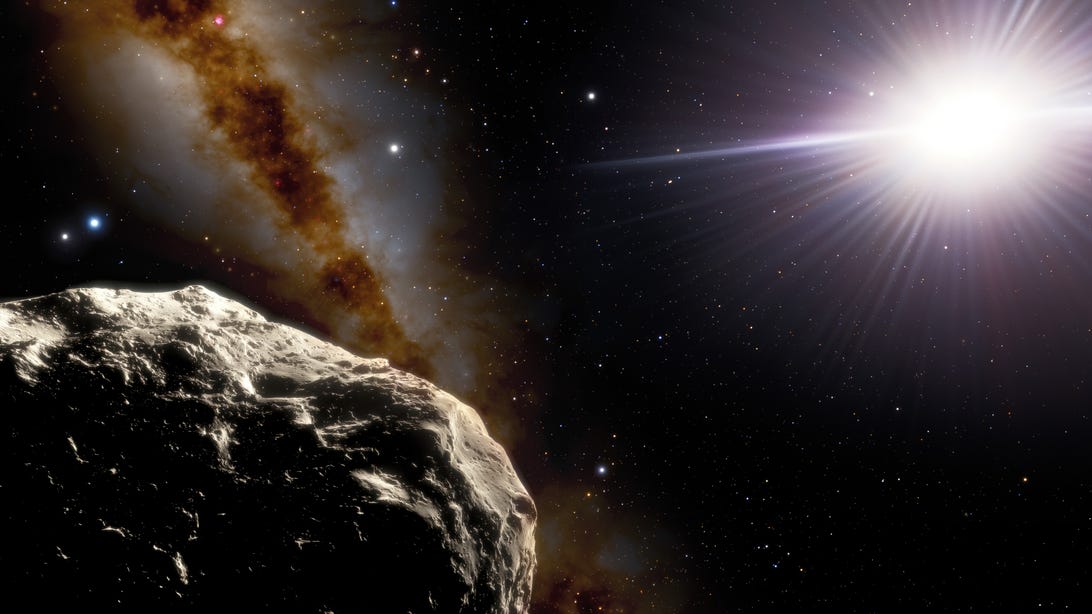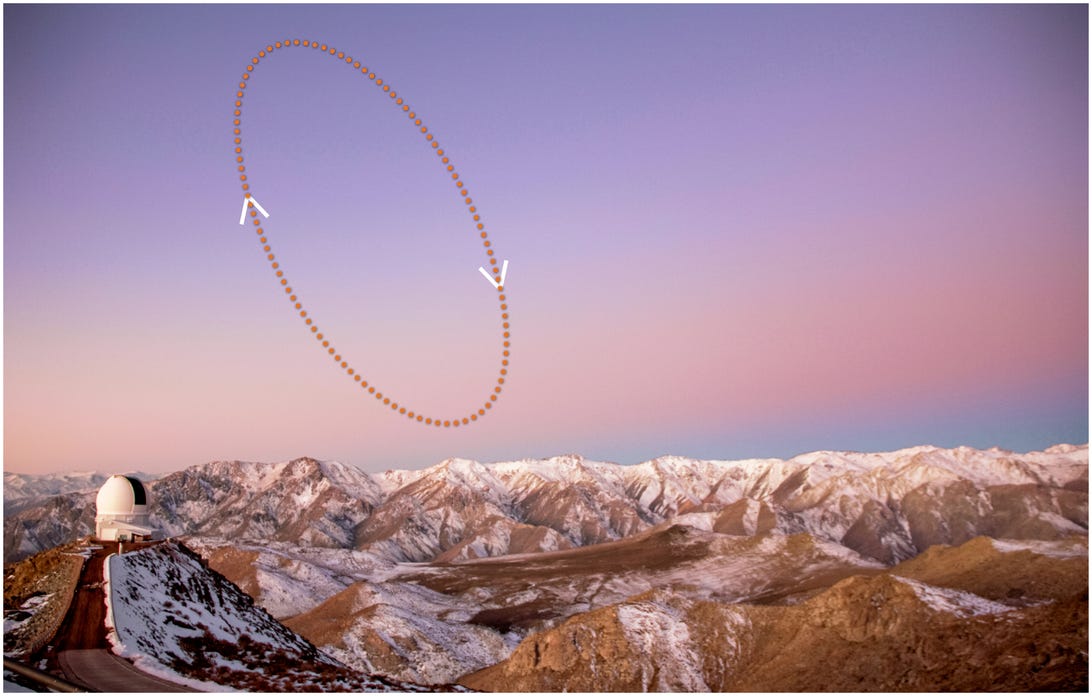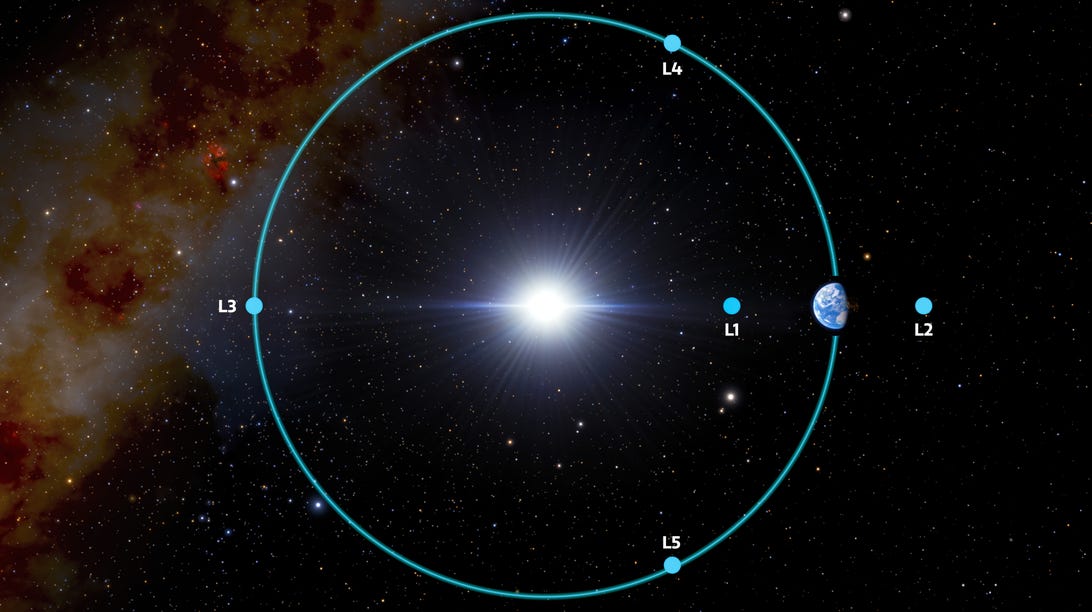
In this illustration, the asteroid is found at the lower left. The two bright points above it on the far left are Earth (right) and the moon. The sun appears on the top right.
NOIRLab/NSF/AURA/J. da Silva/SpaceengineScientists may have just identified the tip of a cosmic motherlode. It’s an asteroid traversing the universe alongside Earth, and its discovery story is a cinematic masterpiece.
The scientific saga begins in December 2020. On a routine sky survey meant to detect asteroids threatening to crash into our planet, a faint smudge appeared — an entity struggling to signal a little “I’m here” to astronomers. For four months, researchers used powerful telescopes, such as the Southern Astrophysical Research Telescope in Chile, to keep watch on the space shard, trying to figure out what it is, where it is and why it is there.
Slowly, they realized the signal was emanating from a nearly mile-wide asteroid dubbed 2020 XL5, but the rock’s location and lore remained a mystery. It was treading too close to the sun, a huge hurdle for ground-based telescopes. And thus, an idea was born.
The researchers reasoned that if 2020 XL5’s signal is hard to see now, maybe it was just as faded in past sky surveys. Maybe it was missed. Sure enough, after searching through 2012-2016 archives of the Dark Energy Survey and Victor M. Blanco 4-meter Telescope, the quiet space rock emerged once again.
Its existence had been overlooked for nearly a decade.
“We suddenly had 10 years of data on this object,” said Toni Santana-Ros, a planetary scientist from the Institute of Cosmos Sciences at the University of Barcelona and the University of Alicante. “This was changing everything. I mean, now, suddenly, we knew we could make a really robust analysis.”
In a paper published Tuesday in the journal Nature Communications, Santana-Ros and fellow researchers concluded that 600 years ago, 2020 XL5 got caught in Earth’s 4th Lagrange point — a region of steadiness along our planet’s orbit strung together by its gravity and the sun’s. The cosmic bit will remain there, they say, for approximately 4,000 years.
Strikingly, 2020 XL5’s positioning deems it an Earth Trojan, or asteroid companion of our planet, that travels right by our side. It’s the second Earth Trojan ever located. And it’s also the largest, standing three times the size of the first one, 2010 TK7.
But most importantly, it proves that things lurk at L4.
“Hayabusa2 from the Japanese agency traveled through the L5 point and Osiris-Rex from NASA traveled through L4,” Santana-Ros explained. “They tried to find objects inside these points, and they could not find them.”
While 2010 TK7 resides around L4 too, Santana-Ros said it was considered an exotic anomaly. “Now,” he added, “we know that there are at least two of them. It’s going in the direction that we can find more.”


Here is where 2020 XL5 would appear in the sky from Cerro Pachón in Chile as the asteroid orbits the Earth-Sun Lagrange point 4, aka L4. The arrows show the direction of its motion. The SOAR Telescope appears in the lower left.
NOIRLab/NSF/AURA/J. da SilvaSpace bases and asteroid mining
Due to the gravitational balance found at all Lagrange points, dust, asteroids, and random galactic objects can easily get stuck there. In fact, these anchor points are so fixed that NASA’s James Webb Space Telescope and ESA’s Gaia surveyor are currently stationed at L2.
Zooming into L4 and L5, Santana-Ros said cosmic items living in these pockets are particularly special because they follow a galactic plane easily accessed by human spacecraft.
“The expensive part of a rocket is to change the inclination and to go to the orbital plane of an asteroid,” Santana-Ros said. “But if it is close to our orbital plane, then it will be cheaper to reach these bodies than reaching the moon, for example.”
Stuff floating in these orbits could be ideal for astronaut science bases, extraterrestrial telescopes, or even be seen as candidates for asteroid mining. “I would say that in the next few decades, if we are discovering more of these objects, they probably will be number one for NASA, ESA, all the space agencies,” Santana-Ros said.


Lagrange points are places in space where the gravitational forces of two massive bodies, such as the sun and a planet, balance out, making it easier for a low-mass object, such as a spacecraft or an asteroid, to orbit there. This diagram shows the five Lagrange points for the Earth-sun system. Note: The size of Earth and the distances in the illustration are not to scale.
NOIRLab/NSF/AURA/J. da SilvaEarth Trojans vs. Jupiter Trojans
If this is all jogging your memory of NASA’s Lucy mission that launched last year toward Jupiter’s Trojan asteroids, you’re not alone. As a quick recap, some of Jupiter’s companion asteroids, the Jupiter Trojans, are believed to be primordial. That means they’ve existed since the beginning of time.
In green, you see the leading and trailing swarms of Jupiter Trojans. That’s where Lucy is headed.
NASANASA is interested in learning about them because they’re essentially remnants of our solar system’s building blocks. The two Earth Trojans, however, aren’t as ancient.
“Both are transient asteroids or transient origin asteroids, meaning that they have not been there forever or since the formation of the Earth,” Santana-Ros said.
Nevertheless, the research team says the sheer existence of these Earth Trojans in L4 is enough to call this an important scientific discovery. Next, they say scientists should begin thinking about pointing their telescopes toward L4 and inventing missions to explore our solar system.
Webb and Gaia, for instance, can’t really observe these points because they’re built to peer out into deep space, not into our solar system. As an example, Webb must be kept super cold because of its infrared imaging processors, so directing itself to the sun would interfere with survey data.
“[L2] is a great place to be if you want to observe in the direction of the galaxy, or even to other galaxies,” Santana-Ros said. “However, if you want to observe toward the sun, it’s a horrible place to be.”
Hopefully, we’ll be seeing a few solar system-focused scopes in the coming years — and follow the asteroid trail to grander cosmic discoveries.


